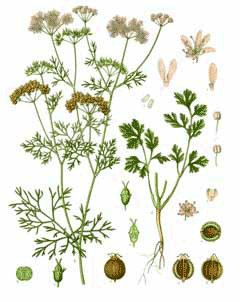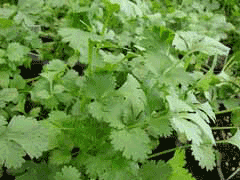 |
|
http://commons.wikimedia.org/wiki/File:Koeh-193.jpg |
 |
| http://www.hear.org/starr/Coriaria microphylla |
Translate this page:
Summary
Physical Characteristics

 Coriandrum sativum is a ANNUAL growing to 0.5 m (1ft 8in) by 0.3 m (1ft).
Coriandrum sativum is a ANNUAL growing to 0.5 m (1ft 8in) by 0.3 m (1ft).
See above for USDA hardiness. It is hardy to UK zone 3 and is not frost tender. It is in flower from June to July, and the seeds ripen from August to September. The species is hermaphrodite (has both male and female organs) and is pollinated by Insects. The plant is self-fertile.
It is noted for attracting wildlife.
Suitable for: light (sandy) and medium (loamy) soils and prefers well-drained soil. Suitable pH: mildly acid, neutral and basic (mildly alkaline) soils and can grow in very alkaline soils.
It can grow in semi-shade (light woodland) or no shade. It prefers dry or moist soil.
UK Hardiness Map
US Hardiness Map
Synonyms
Bifora loureiroi, Coriandropsis syriaca, Coriandrum globosum, Selinum coriandrum
Plant Habitats
Cultivated Beds;
Edible Uses
Edible Parts: Leaves Oil Seed
Edible Uses: Condiment Oil
Leaves - raw or cooked. They are used as a flavouring in salads, soups etc[2, 4, 21, 37, 61] and the fresh leaves are probably the most widely used flavouring herb in the world[268]. The leaves have an aromatic flavour[183]. It is foetid according to another report[4], whilst another says that the fresh leaves have a strong bedbug-like smell[244].. The leaves should not be eaten in large quantities[132]. The fresh leaves contain about 0.012% oxalic acid and 0.172% calcium[240]. Seed - cooked. It is used as a flavouring in many dishes including cakes, bread and curries, it is also widely used to flavour certain alcoholic liquors[2, 4, 5, 21, 27, 37]. The fresh seed has a disagreeable and nauseous smell, but when dried it becomes fragrant, the longer it is kept the more fragrant it becomes[4, 132]. Plants yield about 1¾ tonnes per acre of seed[4]. The root is powdered and used as a condiment[161]. An essential oil from the seed is used as a food flavouring[21, 46, 61, 105]
References More on Edible Uses
Medicinal Uses
Plants For A Future can not take any responsibility for any adverse effects from the use of plants. Always seek advice from a professional before using a plant medicinally.
Antidiarrhoeal Antihalitosis Appetizer Aromatherapy Aromatic Carminative Depurative Expectorant
Narcotic Stimulant Stomachic
Coriander is a commonly used domestic remedy, valued especially for its effect on the digestive system, treating flatulence, diarrhoea and colic[9, 244]. It settles spasms in the gut and counters the effects of nervous tension[254]. The seed is aromatic, carminative, expectorant, narcotic, stimulant and stomachic[4, 9, 21, 46, 147, 178, 201, 238]. It is most often used with active purgatives in order to disguise their flavour and combat their tendency to cause gripe[4, 244]. The raw seed is chewed to stimulate the flow of gastric juices and to cure foul breath[240, 268] and will sweeten the breath after garlic has been eaten[254]. Some caution is advised, however, because if used too freely the seeds become narcotic[4]. Externally the seeds have been used as a lotion or have been bruised and used as a poultice to treat rheumatic pains[254, 268]. The essential oil is used in aromatherapy. Its keyword is 'Appetite stimulant'[210]. The German Commission E Monographs, a therapeutic guide to herbal medicine, approve Coriandrum sativum (Coriander - Dhania) for dyspepsia, loss of appetite (see [302] for critics of commission E).
References More on Medicinal Uses
The Bookshop: Edible Plant Books
Our Latest books on Perennial Plants For Food Forests and Permaculture Gardens in paperback or digital formats.

Edible Tropical Plants
Food Forest Plants for Hotter Conditions: 250+ Plants For Tropical Food Forests & Permaculture Gardens.
More

Edible Temperate Plants
Plants for Your Food Forest: 500 Plants for Temperate Food Forests & Permaculture Gardens.
More

More Books
PFAF have eight books available in paperback and digital formats. Browse the shop for more information.
Shop Now
Other Uses
Essential Fuel Fungicide Insecticide Oil Repellent
An essential oil from the seed is used as a food flavouring, in perfumery, soap making etc[21, 46, 61, 74, 105]. It is also fungicidal and bactericidal[238]. The growing plant repels aphids[14, 20, 201]. A spray made by boiling of one part coriander leaves and one part anise seeds in two parts of water is very effective against red spider mites and woolly aphids[201]. An oil from the seed is used for making soap[74]. The report does not make it clear if the essential oil or the fixed oil is used[K]. The seed contains about 20% fixed oil[240], this has potential for industrial use in Britain, it could become an alternative to oilseed rape though the oil content is a bit on the low side at present (1995). The oil can be split into two basic types, one is used in making soaps etc, whilst the other can be used in making plastics[234]. The dried stems are used as a fuel[74].
Special Uses
Attracts Wildlife Scented Plants
References More on Other Uses
Cultivation details
Prefers a warm dry light soil[4, 27, 37]. Plants grown mainly for their seeds do well in partial shade, but when growing for the seed or essential oil a sunny position is preferred[238]. The plants dislike constant moisture[14] or too much nitrogen[200]. Another report says that coriander grows best when a cool damp spring is followed by a hot dry summer[238]. Coriander tends to run quickly to seed if the plants are too dry at the seedling stage[238]. Plants tolerate a pH in the range 4.9 to 8.3. Coriander is often cultivated, both on a garden scale and commercially, for its edible seed[4, 142], there are some named varieties[183]. The plant is fast-growing, ripening its seed without difficulty in Britain and it seems to be free of pests and diseases[234]. The seeds have been used medicinally and as a food flavouring since ancient times, and were introduced into Britain by the Romans[244]. In the Middle Ages they were added to love potions because of their reputation as aphrodisiacs[244]. The plants flowers are very attractive to pollinating insects[14, 18, 201]. Coriander is in general a good companion plant in the garden, helping to repel aphis and carrot root fly[238]. It grows well with anise, improving the germination rate when the two species are sown together[14, 18, 20, 238], but it grows badly with fennel, where it acts to reduce the seed yield of the fennel[14, 18, 20, 201, 238]. Coriander also grows particularly well with dill and chervil[201].
References Carbon Farming Information and Carbon Sequestration Information
Temperature Converter
Type a value in the Celsius field to convert the value to Fahrenheit:
Fahrenheit:
The PFAF Bookshop
Plants For A Future have a number of books available in paperback and digital form. Book titles include Edible Plants, Edible Perennials, Edible Trees,Edible Shrubs, Woodland Gardening, and Temperate Food Forest Plants. Our new book is Food Forest Plants For Hotter Conditions (Tropical and Sub-Tropical).
Shop Now
Plant Propagation
Seed - sow April in situ[1, 37]. The seed is slow to germinate and so on a garden scale it can also be sown in March in a cold frame. Sow a few seeds in each pot and then plant them out when they are growing away strongly in May[4]. The seed can also be sown in situ in the autumn[1]. Autumn sown plants will grow bigger and produce more seed.
Other Names
If available other names are mentioned here
Native Range
Afghanistan, Iran, Lebanon-Syria, North Caucasus, Pakistan, Palestine, Saudi Arabia, Sinai, Transcaucasus, Turkey.
Weed Potential
Right plant wrong place. We are currently updating this section.
Please note that a plant may be invasive in one area but may not in your area so it's worth checking.
Conservation Status
IUCN Red List of Threatened Plants Status :

Growth: S = slow M = medium F = fast. Soil: L = light (sandy) M = medium H = heavy (clay). pH: A = acid N = neutral B = basic (alkaline). Shade: F = full shade S = semi-shade N = no shade. Moisture: D = dry M = Moist We = wet Wa = water.
Now available:
Food Forest Plants for Mediterranean Conditions
350+ Perennial Plants For Mediterranean and Drier Food Forests and Permaculture Gardens.
[Paperback and eBook]
This is the third in Plants For A Future's series of plant guides for food forests tailored to
specific climate zones. Following volumes on temperate and tropical ecosystems, this book focuses
on species suited to Mediterranean conditions—regions with hot, dry summers and cool, wet winters,
often facing the added challenge of climate change.
Read More
Expert comment
Author
L.
Botanical References
200
Links / References
For a list of references used on this page please go here
Readers comment